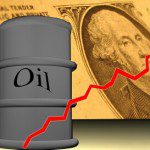The gold/oil ratio is recognized as a sort of canary in a coal mine, giving advance warning of  turbulence ahead and, for the first time in 3 years, the ratio is below 20-to-1 compared to its historical average of 15-to-1. Were it to go above 20-to-1, making gold too expensive or oil too cheap, and we would be in crisis mode.
turbulence ahead and, for the first time in 3 years, the ratio is below 20-to-1 compared to its historical average of 15-to-1. Were it to go above 20-to-1, making gold too expensive or oil too cheap, and we would be in crisis mode.
The original article has been edited here for length (…) and clarity ([ ])
Spikes in the ratio preceded a number of financial calamities including the Asian currency crisis of the late ‘90s, the Great Recession and, most recently, the Euromarket predicament. The ratio peaked near 47-to-1 in February 2016 when West Texas Intermediate (WTI) crude dipped below the $27-a-barrel level. Since then, the ratio has lurched lower as oil prices have risen and, with WTI now topping $70, the ratio has punched through the 20-to-1 floor. You can see the ratio’s recent track record in the chart below.

At face value, the gold/oil ratio’s decline could easily be taken as a sign that some sense of normalcy is returning to the markets. Normalcy, of course, isn’t authoritatively defined. Maybe it’s better to say that that the decline heralds a return to normal volatility. That notion seems reasonable given the ratio’s correlation to the Cboe Volatility Index (VIX) as illustrated in the chart below.

In this sense, the gold/oil ratio is an indicator of market sentiment. Still, one can’t ignore the fundamentals at work in the underlying markets: global oil prices are being levered upward by OPEC production cuts and Middle East flare-ups while gold is weighed down by growing prospects of interest rate hikes and a stronger dollar.
I’m betting that there’s a link between the optimism conveyed by the falling gold/oil ratio and the bread-and-circuses fervor expressed in a ratio we examined last week. Is such optimism really warranted or are investors too exuberant? Time will tell…
Related Articles From the munKNEE Vault:
1. Is Gold Too Pricey – OR – Is Oil Is Too Cheap?
There’s a relationship between gold and oil that’s worth understanding because each, being valued in U.S. dollars, putatively serves as a measure of inflation and, since both commodities have a common denominator, it’s easy to price one against the other. Ergo, the gold/oil ratio i.e. the price of gold expressed in barrels of crude, and the current gold/oil ratio begs the question: “Is gold getting pricey or is oil too cheap?
2. Historical 92.3% Gold/Oil Correlation Suggests Gold Is Currently Undervalued By?
Since 1970 there has been a 92.3% correlation between the price of gold and oil. The current gold to oil ratio is 11.8. If the ratio were to resume its historical average of 15.5, the gold price would be…
3. Gold Should Be At Least At $2,040/ozt. – Here’s Why
The value of gold relative to oil (Brent Crude) is an embarrassing 11.2 to 1 ratio – way below its historical average – thanks to the manipulation by the Fed and member banks. When the price revalues higher it will do so SHARPLY and it will be PAINFUL for those on the wrong side of the trade or in worthless paper assets. Let me explain why that is the case.
4. Physical Gold vs. Black Gold: A Comparison
Since gold is physical liquid money and oil is an essential commodity for the economy, it is normal that they correlate negatively in real prices. When the economy goes well, demand for oil increases, whereas demand for gold diminishes. However, if inflation hits, the nominal prices of both assets increases at the same time with inflation…
For all the latest – and most informative – financial articles sign up (in the top right corner) for your FREE tri-weekly Market Intelligence Report newsletter (see sample here)
Support our work: like us on Facebook, follow us on Twitter, or share this article with a friend. munKNEE.com – the internet’s “most unique” financial site!
 munKNEE.com Your Key to Making Money
munKNEE.com Your Key to Making Money